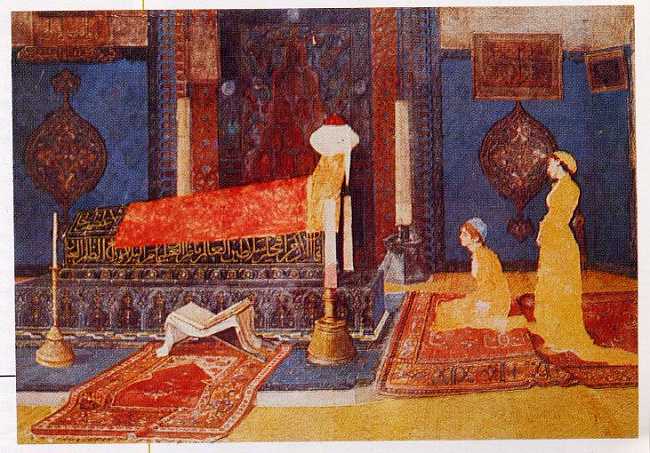Posted by Ali R.Tuna on 02-04-2004 04:36 PM:
Paintings from Osman Hamdi bey and more rugs
Dear Turkotekers,
Further to the comments of Filiberto in the last tread ,
I am posting two pictures from Osman Hamdi bey , painter , pupil of Jean Louis
Gerome and the founder of the Turkish islamic Art Museum and Archeology Museums.
Osman Hamdi bey was representing the oriental objects with high precision in
his paintings. He particularly liked to render the architectural settings , the
interior decorations and the carpets.
The first picture called the Carpet
Merchant ( which he has donated to Wilhelm von Bode in Berlin Museum) represents
the still classical scenery of a Western family being marvelled to carpets.
Their guide behind them , is probably stunned by the price asked. I find the
attitudes of each person in the scenery so real !

All three rugs in
the forefront are Caucasians (please give us the types) while the one shown on
the back is a central Anatolian of a well known type with ramheads (see
C.Alexander collection for a similar one).

This carpet
is represented again on the right , on the second picture called "Two ladies in
a shrine" . The rug on the left on this picture is a Milas from Western
Anatolia.

Ali
Posted by Filiberto Boncompagni on 02-05-2004 08:20 AM:
Hi Ali,
Thank you for presenting an Oriental
Orientalist!
Incidentally, "Googling" the web for Osman Hamdi I found
this:
Pascal Sebah (1823-1886) was a leading photographer in
Constantinople, now the city of Istanbul. Constantinople, composed of many
diverse peoples, was the capital of the Ottomon Empire and Sebah's career
coincided with intense Western European interest in the "Orient," which was
viewed as exotic and fascinating. Constantinopolitan photographers, such as
Sebah and Abdullah Freres, had a ready market selling images to tourists -- of
the city, ancient ruins in the surrounding area, portraits, and local people in
traditional costumes, often holding water pipes. Sebah rose to prominence
because of his well-organized compositions, careful lighting, effective posing,
attractive models, great attention to detail, and for the excellent print
quality produced by his technician, A. Laroche.
Sebah's career was
accelerated through his collaboration with the artist, Osman Hamdi Bey
(1842-1910). Osman Hamdi Bey posed models, often dressed in elaborate costumes,
for Sebah to photograph. The painter then used Sebah's photographs for his
celebrated Orientalist oil paintings. In 1873, Osman Hamdi Bey was appointed by
the Ottoman court to direct the Ottoman exhibition in Vienna and commissioned
Sebah to produce large photographs of models wearing costumes for a sumptuous
album, Les Costumes Populaires de la Turquie. The album earned Sebah a gold
medal, awarded by the Viennese organizers, and another medal from the Ottoman
Sultan Abdulaziz.
Like his master Gerome, Hamdi used photographs for
his paintings… No wonder they produced very accurate pictures. In any case, this
doesn’t make their works less enjoyable.
As for the attribution of the
three Caucasians, the one in the middle is easy.
 Well, almost easy - in fact that design
has two denominations in the trade:
Well, almost easy - in fact that design
has two denominations in the trade:
- Surahani, sub-category of
Shirvan-Baku
- Orduthck Konakgend, sub-category of Kuba. Whatever, it’s
East Caucasus.
The other two are more difficult.
The one on the
right could be a Khila, again from the Shirvan-Baku region.

The one on the left is very
unclear. That sort of half medallion visible at the end reminds me the "gubpa"
ornament mentioned by Bennett (page 209 of "Caucasian") in relation to "hexagon
columns" Shirvans…

I
don’t know…
Regards,
Filiberto
Posted by Wendel Swan on 02-17-2004 11:01 AM:
Dear Filiberto and all,
Filiberto, you point out that the design in
the central rug in “The Carpet Merchant” has two denominations in the trade:
Surahani and Orduthck Konakgend.
The most common name given to this class
of rug in the trade would be “Golden Shirvan.” The absence of any reds indicate
that it was bleached, a practice that some assume is only of recent origin. This
painting demonstrates that some rugs were bleached at least 100 years
ago.
Wendel



 Well, almost easy - in fact that design
has two denominations in the trade:
Well, almost easy - in fact that design
has two denominations in the trade:
